These 5 mini power drills will supercharge your athletic coordination: dynamic rebound sequences for precision footwork, lateral bounce patterns to enhance balance control, multi-directional jumping to develop neural pathways, alternating tempo rebounds for rhythmic coordination, and single-leg stability training on mini trampolines. You’ll improve proprioception, reaction time, and neuromuscular efficiency in just minutes per day. These quick exercises deliver maximum results when incorporated consistently into your training routine.
Dynamic Rebound Sequences for Precision Footwork
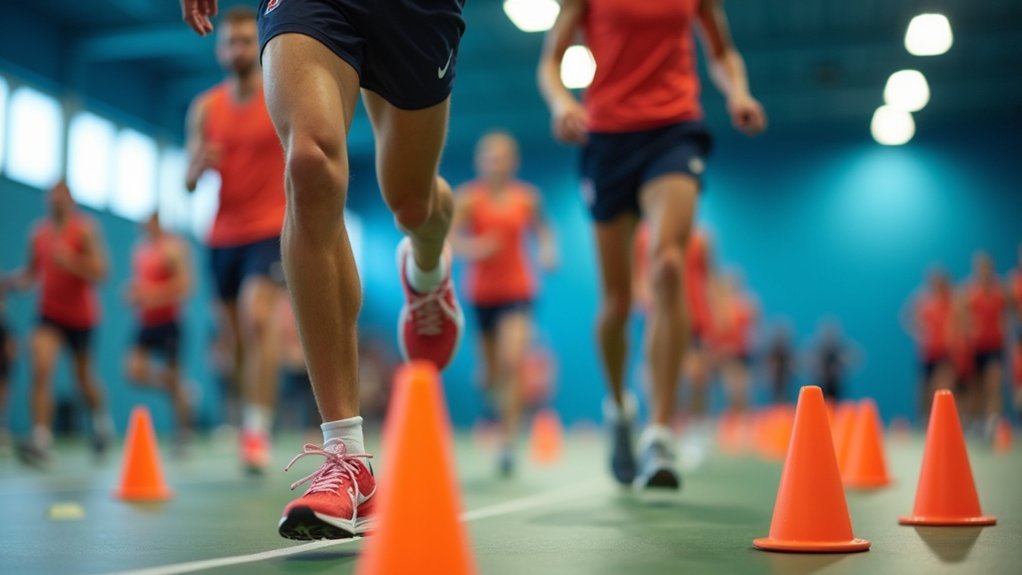
While many athletes focus primarily on strength or endurance, dynamic rebound sequences offer a powerful way to develop the precise footwork that separates good athletes from great ones.
You’ll enhance your agility training by implementing drills like lateral plyometric jumps and dot drills that demand explosive power and rapid directional changes.
Tools like agility ladders and cones help you develop superior spatial awareness and footwork precision during these coordination training exercises. Regular practice improves your proprioception and reaction times, allowing you to respond more effectively during competition.
Specialized training equipment enhances spatial awareness and refined movement patterns essential for elite competitive performance.
Incorporate shuttle runs and plyometric agility drills to boost both speed and force production simultaneously. These targeted sequences train your neuromuscular system to execute complex movements efficiently, dramatically improving your athletic performance when it matters most.
Lateral Bounce Patterns to Enhance Balance Control
Once you’ve mastered basic footwork drills, lateral bounce patterns offer a next-level challenge that greatly enhances your balance control during athletic movements.
These side-to-side exercises engage your core muscles while developing proprioception—your body’s awareness of its position in space. Your ankle stability markedly improves as you practice these patterns, helping prevent injuries when changing directions quickly.
You’ll also boost your ability to absorb force and produce it efficiently during competitive play.
To maximize benefits, focus on:
- Maintaining a low center of gravity during each lateral bounce
- Engaging core muscles throughout the entire movement sequence
- Gradually increasing speed while preserving proper form
With consistent practice, you’ll notice enhanced coordination and agility, allowing you to navigate dynamic environments more effectively and react faster when balance is challenged.
Multi-Directional Jumping for Neural Pathway Development
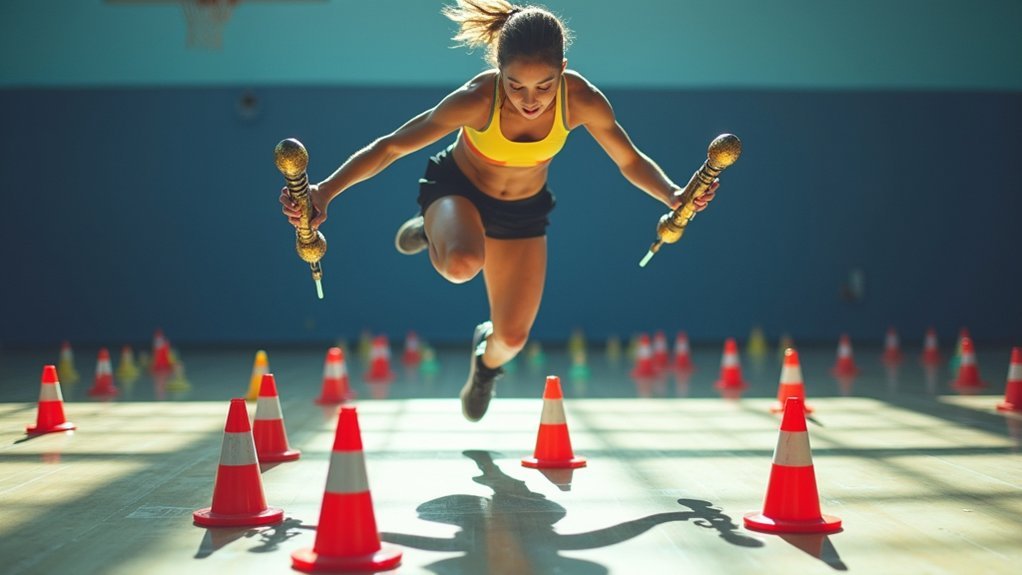
Multi-directional jumping drills enhance your brain’s neural pathways by challenging your body to adapt to varied movement patterns.
When you incorporate lateral jumps and diagonal hops into your training routine, you’re simultaneously building proprioception, balance, and coordination—all critical components for superior athletic performance.
Research shows these exercises specifically target fast-twitch muscle fibers, improving your reaction time and movement efficiency.
You’ll notice significant gains in both agility and explosiveness during competitive play as your body learns to process and respond to dynamic situations more effectively.
Beyond physical benefits, consistent multi-directional jumping fosters cognitive adaptability, sharpening your ability to anticipate opponents’ movements and respond appropriately.
Your brain develops new neural connections that help you make split-second decisions with greater confidence and precision.
Alternating Tempo Rebounds for Rhythmic Coordination
Alternating tempo rebounds represent one of the most effective methods for developing the rhythmic coordination athletes need for peak performance.
You’ll enhance your hand-eye coordination while training your body to adapt to changing game speeds, ultimately improving your ability to make quick decisions under pressure.
For maximum neuromuscular efficiency, incorporate these practices:
- Bounce a ball at varying speeds while maintaining control, gradually increasing the complexity of your patterns.
- Add music with different beats per minute to create auditory cues for tempo changes.
- Focus on body awareness during shifts between speeds to improve overall athletic coordination.
Through consistent practice, you’ll develop fluid responses to dynamic movements, allowing your body to synchronize more effectively during competition—translating directly to superior performance in sports requiring rhythmic adaptability.
Single-Leg Stability Training on Mini Trampolines
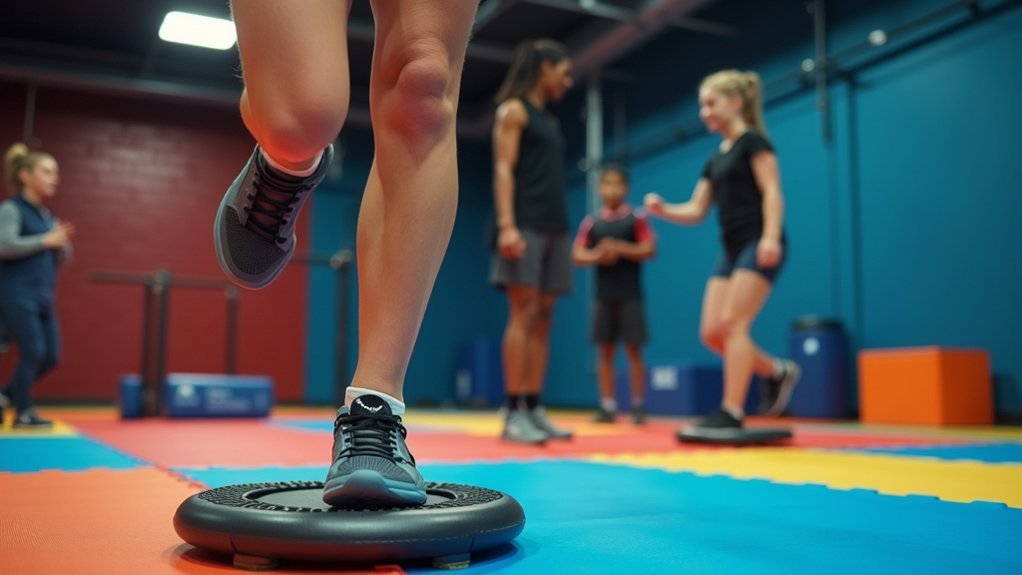
While traditional balance training offers benefits, single-leg stability work on mini trampolines transforms ordinary balance exercises into powerful neurological development tools. You’ll activate stabilizer muscles more effectively as your body adapts to the unstable surface, improving coordination and preventing injuries.
| Benefit | Training Focus | Athlete Application |
|---|---|---|
| Enhanced proprioception | Force absorption | Maintain control during dynamic movements |
| Increased muscle strength | Movement patterns | Prevent knee and ankle injuries |
| Better balance recovery | Core engagement | Improve agility in direction changes |
| Athletic coordination | Single leg stability | Execute explosive movements effectively |
When you practice these drills regularly, you’ll develop stronger stabilizer muscles in your ankles and knees. Athletes can benefit tremendously, as research shows significant improvements in performance metrics during agility drills that require quick directional changes.
Frequently Asked Questions
Which Exercise Drill Can Improve Coordination?
You’ll improve coordination with any of these exercises: Lateral Plyometric Jumps, Forward Running High-Knee Drills, Dot Drills, Shuttle Runs, or Jumping Jack Variations. They all enhance different aspects of your movement efficiency and body control.
What Are 3 Drills That Train Your Agility?
You’ll boost your agility with shuttle runs, which train quick direction changes, dot drills that develop explosive footwork, and L drills (cone drills) that force you to make sharp turns at speed.
Which Jumping Exercise Can Build Power and Improve Coordination?
Lateral plyometric jumps will build your explosive power and enhance coordination. You’ll develop better balance as you jump side-to-side, engaging multiple muscle groups simultaneously. They’re ideal for improving your ability to change direction quickly.
How to Improve Foot Coordination?
You’ll improve foot coordination by practicing jump rope exercises, agility ladder drills, dot drills, and shuttle runs. Don’t forget dynamic warm-ups with high-knees and butt-kicks to enhance your quick footwork and directional control.
In Summary
You’ll find mini trampoline drills transformative for your athletic development. By incorporating these five power drills regularly, you’re building neural connections that enhance your overall coordination and balance. They’re not just fun – they’re functional training tools that strengthen your body’s movement intelligence. Start with just 5-10 minutes daily, and you’ll notice improved precision, quicker reactions, and better body control in your primary sport.

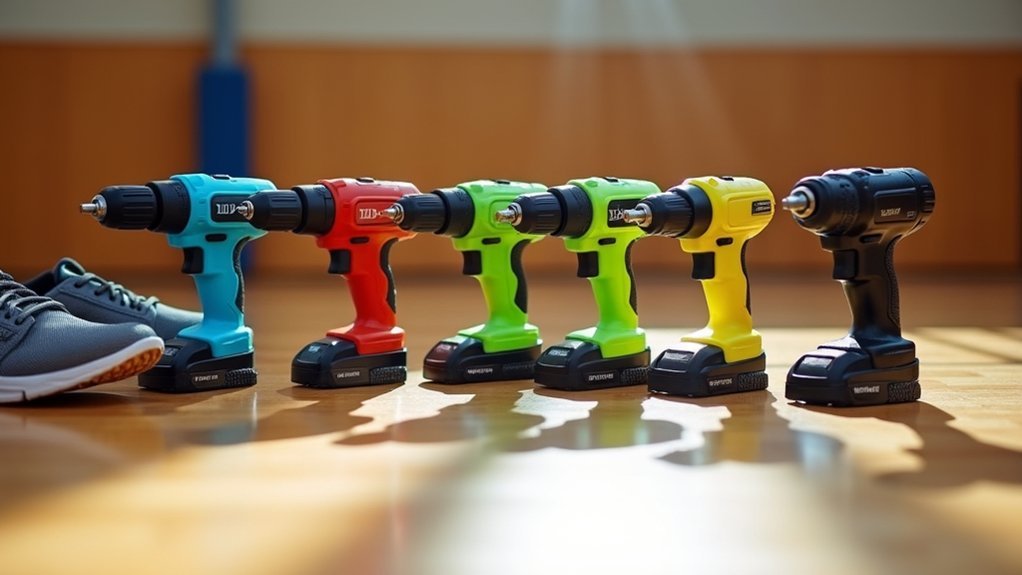
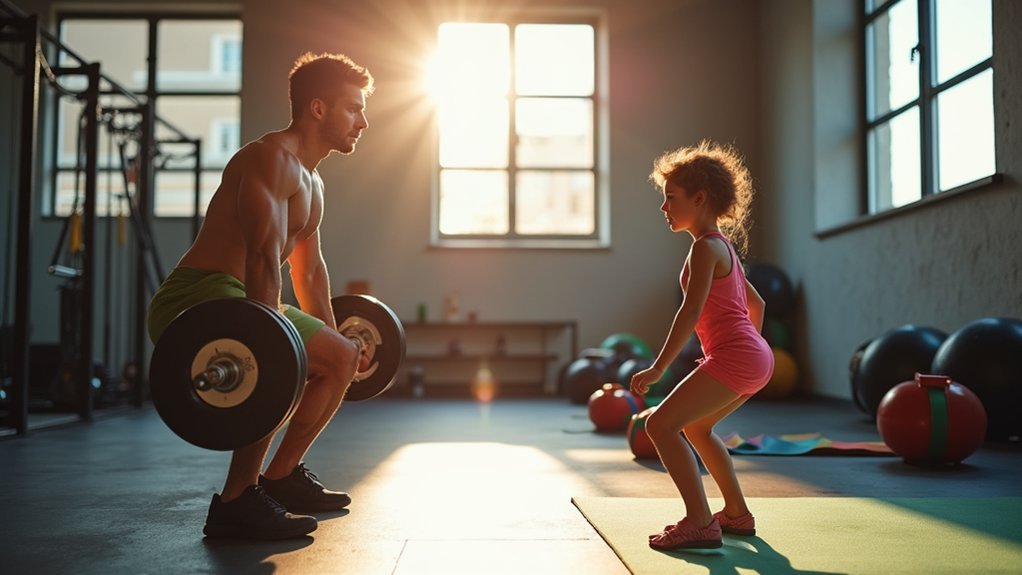


Leave a Reply